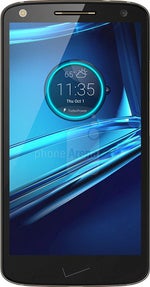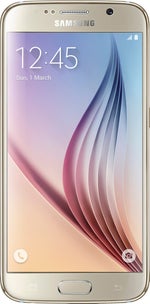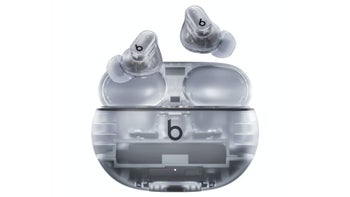Motorola DROID Turbo 2 vs Samsung Galaxy S6

Introduction
Almost hard to believe, the Samsung Galaxy S6 has been around for nearly 8 months now. That’s a long time come to think of it, considering how rapidly things evolve in such a short period of time. Throughout 2015, the Galaxy S6 has remained relevant, which is an impressive feat for a handset that was released in the beginning of the year. Even with all the newcomers, Samsung’s flagship is a force to be reckoned with.
Motorola on the other hand, now a Lenovo company, has been busier towards the latter portion of the year. After turning heads with the Moto X Pure Edition, it didn’t take long before we got wind of its latest DROID. Capitalizing on the success of its predecessor, the Motorola DROID Turbo 2 continues to do what it does best – and that’s to deliver the best battery life around!
Two awesome Android powered smartphones, but there can only be one that reigns supreme.
Design
One favors a striking design, while the other opts for utility above everything else. The Samsung Galaxy S6 is, without question, the more visually appealing smartphone. Sporting that glass meeting metal design we’ve come to adore, it’s undoubtedly exhibiting premium qualities worthy of its flagship status, but at the same time, it makes it fragile.
That’s where the DROID Turbo 2 steps up to the plate with its tank-like construction. Sure, its design is subdued looking in comparison to its rival, but its near indestructible quality gives it added utility that few phones offer. Drops don’t faze this phone, thanks in part to its ShatterShield display, which protects it from cracking in the event it’s dropped – even onto solid pavement. Despite the bland design language of the phone, some folks will appreciate its customization via Moto Maker.
While the Galaxy S6 boasts the characteristics that capture the attention of onlookers with its premium tastes, the DROID Turbo 2 goes the opposite route with its rugged-like construction. Either one works, but it mainly hinges on your particular taste.
For the DROID Turbo 2, some of its notable design features include dual front-firing speakers, an LED flash for its front-facing camera, wireless charging, and expandable storage via its microSD card slot. Conversely, the Galaxy S6 counters with goodies such as a fingerprint sensor, wireless charging, IR blaster, and a heart rate sensor.
Display
The Samsung Galaxy S6 is remarkable for the fact that it’s fashioned with one of the most detailed screens this year – a 5.1-inch Quad-HD Super AMOLED display. The DROID Turbo 2, however, is just as detailed with its 5.4-inch Quad-HD AMOLED screen and 544 ppi pixel density.
Beyond the details, everything else points to the obvious here – that the Galaxy S6 has the superior display. Not only does it procure a higher luminance of 563 nits and a warmer color temperature, it’s also more color accurate in the sRGB color spectrum.
Interface and Functionality
Comparing their respective Android experiences is a tough cookie, especially when they clearly cater to different users. On one hand, we like that the stock-like Android 5.1.1 Lollipop experience of the DROID Turbo 2, just because it’s the simpler, more straightforward, and uncomplicated experience. Yes, there are influences from Motorola, but they are features that complement the experience in a meaningful way – rather than convoluting it.
Well, it’s a stark difference with the Galaxy S6 and its TouchWiz interface. Although it’s not as clean looking as the DROID Turbo 2’s visuals, it’s far more refined over previous iterations. Add to that, TouchWiz comes with an incredible set of features that help power users get stuff done. From its true multi-tasking functionality, to how the interface can be shrunken down to a thumb-reaching friendly size, and its downloadable themes, there’s just greater depth at play here that caters to power users.
Both experiences suffice from a superficial standpoint, considering that they offer all the fundamental features of Android. It’s just a matter of which one appeals to you more: whether it’s the stock-like feel of the DROID Turbo 2, or the diversified portfolio of the Galaxy S6’s software features.
System Performance
All of the synthetic benchmark tests we ran indicate one obvious fact, it’s that the Galaxy S6’s Exynos 7 Octa 7420 chipset just outperforms the DROID Turbo 2’s Snapdragon 810 processor. Don’t believe us? Just look for yourself in the list below. However, as we all know, synthetic benchmark tests should be taken with a grain of salt.
There’s certainly a lot of responsiveness out of the two handsets, but after spending a considerable amount of time with them, the DROID Turbo 2 continues to have a snappier operation using it day-to-day. While the Galaxy S6 is the most powerful device in the series ever, it can still be bogged down every now and then, especially after months of using it and installing various apps. As for graphics processing, we’re certainly pleased by their handling – they sustain smooth enough frame rates to enjoy all of today’s demanding titles.
Camera
The newcomer, the DROID Turbo 2 in this case, comes out of the gate with the beefier camera of the two – a 21-megapixel snapper that features an f/2.0 aperture lens. No doubt, it makes it a formidable camera when we compare it to the Galaxy S6’s 16-megapixel camera, but having a higher megapixel count camera is never a true indicator of a camera’s performance.
However, we will certainly say that the Galaxy S6 makes for a more convincing package thanks to its shooting experience, which is comprised out of several shooting modes and a useful Pro mode. The latter one, specifically, provides hardcore shutterbugs with all the tight controls that’s necessary in capturing the moment perfectly. In comparison, the DROID Turbo 2 favors a simpler experience – one that’s lighter on the goodies.
Image Quality
Motorola has made some great strides, seeing that their devices have been regarded as underperforming in the past, but despite the tremendous improvements made with the DROID Turbo 2’s camera, the Galaxy S6 is still the better handset. In just about every scenario, Sammy’s pride and joy delivers the better results. Not only are photos surprisingly sharper and more detailed, but its warmer color reproduction commands more attention. The DROID Turbo 2, by today’s standards, is still a good performer, however, it just can’t match the attentiveness of its rivals.
That point is even evident under low light conditions, where the Galaxy S6 continues its dominance. Despite how they both produce brightly toned photos when lighting is insufficient, it’s yet again the Galaxy S6 capitalizing with its better details capture. Sure, its color reproduction is heavily warmer in tone under artificial lighting, but it still looks somewhat more appealing than the duller, cooler tones out of the DROID Turbo 2.
Video Quality
Although the Galaxy S6 tips the scales with its better still shot performance, there’s actually not much of a gap when it pertains to video recording quality. Having both topping out at 4K UHD resolution, there are plenty of rich details captured by the two, as well as some other similar, favorable qualities – such as quick focus and exposure adjustment. As before, the Galaxy S6 continues to favor warmer color tones, whereas it’s cooler with the DROID Turbo 2. And even though voices recorded by the microphones are audible, there’s more clarity with the S6.
Multimedia
Granted that the Google Play Music app comes preloaded on the two phones, the Galaxy S6 complements it with its very own, homemade TouchWiz music player. Functionally, it suffices, but in the greater scheme of things, it doesn’t necessarily take the punch out of Google’s venerable player.
Unfortunately, neither phone's loudspeaker is accompanied with any sort of meaningful bite, as they sound a bit subdued and unsubstantial.
Once an added commodity, the Galaxy S6 is one of the few phones released this year to feature an IR blaster, which allows it to double as a handy universal remote. Not everyone uses it, but it’s nonetheless there for the convenience when the opportunity arises. We can’t say the same thing for the DROID Turbo 2.
Call Quality
Phone calls are done in a typical manner by the two phones, but in all fairness, there’s not a single one that extraordinarily better than the other. Overall, we find their performance to be average-like – where they’re sufficient for most cases, but still come with some challenges. There’s this hissy sound with the Galaxy S6’s earpiece, while the DROID Turbo 2 exhibits robotic sounding voices.
Battery
Way before we get into the nitty-gritty, we have this inkling of which one offers the superior battery life. The DROID Turbo 2’s reputation precedes it, especially when its predecessor established new heights with its long-lasting results. And to no one’s surprise, the DROID Turbo 2 similarly follows by obviously producing the longer battery. You know it’s kind of expected when it’s the one packing the larger capacity 3760 mAh battery, whereas the Galaxy S6 is endowed with a meager 2550 mAh battery.
Day-to-day usage, we’re able to eclipse a solid one-day of normal usage with Samsung’s pride and joy, but the DROID Turbo 2 easily surpasses that at 1.5 days. That point is reaffirmed in our benchmark test, where the DROID Turbo 2 reaches a continuous on-screen time of 8 hours and 1 minute – versus the Galaxy S6’s mark of 7 hours and 14 minutes. Needless to say, the Galaxy S6 is good, but the DROID Turbo 2 is better.
Recharge times are also superb, requiring very little down time before they’re back to full capacity. Even though the Galaxy S6 accomplishes the task at the speedier time of 78 minutes, we really have to applaud the DROID Turbo 2 because it’s not too far behind at 82 minutes, which is impressive knowing the huge disparity between their capacities – it’s far more efficient with the task on hand! Best of all, too, we have the added convenience of wireless charging at our disposal with them.
Conclusion
Having been on the market for quite some time now, the Samsung Galaxy S6 benefits from having a lower outright cost at this point. Nowadays, we can find Sammy’s flagship at the fraction of its original starting cost – going for roughly around $450 depending on where you look. That’s not too shabby because between the two, it comes with some added luxuries that aren’t found with the DROID Turbo 2, giving it that more bang for the buck quality.
On the other side of the fence, the Motorola DROID Turbo 2 commands a higher cost because it’s newer, only having been launched less than a month ago at this point. So yeah, it’s no surprise to anyone that it’s attached with an outright cost of $624.00. Knowing that they’re almost similarly spec’d, endowed with some delicious hardware, the tide tips in favor of the Galaxy S6.
Well, it’s not to say that you don’t get the same level of value with Motorola’s product, but there’s no denying that the Galaxy S6 set of the bar really high when it was released. While the DROID Turbo 2 can’t match the kind of value we get out of the Galaxy S6 at this time, it’s the phone to go with if you really want something that focuses its attention primarily on delivering outstanding battery life and extra toughness. That, folks, is its bread and butter.
Beyond that, however, the Galaxy S6 shows why it’s the benchmark Android smartphone. From its rich set of features, to its still relevant specs sheet, and updated design language, the Galaxy S6 offers substantial value given its lower price point now. Rest assured, it’s still a formidable thing that’s in contention even as we head into this holiday season.
Motorola DROID Turbo 2
Pros
- Longer lasting battery life
- Indestructible ShatterShield display
- Customizable design
- Expandable storage via microSD slot
- Stock-like Android experience if faster
Samsung Galaxy S6
Pros
- Lower price point
- Premium design language
- Camera snaps better looking photos
- Diversified camera shooting experience
- TouchWiz caters to power users




























Things that are NOT allowed: